DEAR FRIENDS. IF YOU LIKE THIS TYPE OF CONTENT, SUPPORT SOUTHFRONT WORK :
MONERO (XMR): 8332UX6Ero53cnz2dKzmfRYtDa5DZ9wRsBfKHcYPHzTvBTTSgLGaC8f8Eo8QsmaoRsCosURvfjv4uiyFcm2WHEf5TfuRYY9
BITCOIN (BTC): bc1q2u872wf5t6tunuzxc5jq6wzz5jwr3ew2q8htxw
BITCOIN CASH (BCH): qqrjde2cq9g473687utlwh4p7ngdaacca5wdraxatl
PAYPAL, WESTERN UNION etc: write to info@southfront.org , southfront@list.ru
Written by Alex Gallant exclusively for SouthFront
1. Key events of the Taliban’s self-proclaimed government in 2021
Only four months after the start of the Taliban’s blitzkrieg-like advance through Afghanistan, the offensive ended with the surrender of Kabul in mid-August 2021. This news raises questions to even the most oblivious individuals concerning military affairs: How can 20 years of training, funding and supplying state of the art technologies could end up in such a swift defeat? Looking at the data gathered at the tactical level, the Afghan National Army (ANA) usually inflicted an amount of casualties considerably superior compared with the Taliban’s number. So how is it possible?
To truly understand ANA’s failure to effectively counter the Taliban’s advance, we need to understand the level of corruption creeping through the army’s ranks since the establishment of a democratic government following the American invasion in 2001. In a 2016 investigation from the Helmand’s provincial council, it was found that approximately 40% of the ANA’s workforce only existed on paper. This means that during that time, out of the 25,000 troops posted to confront the Taliban in the Helmand province, only 15,000 were actually deployable for combat. This matter was still the case when on November 10th of last year, Khalid Payenda, former finance minister of Afghanistan, revealed that around 300,000 enlisted soldiers were in fact “ghost-soldiers” used by corrupt officials to collect their salaries. This would bring down the actual numbers of soldiers to around 40,000 to 50,000, according to him. This incredible level of corruption alone explains the military catastrophe of the past months, although many other factors should be weighed in before making a sound judgment of the situation.
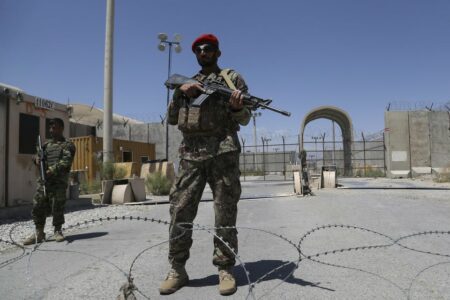
An Afghan National Army (ANA) soldier stands guard at Bagram Air Base, after the departure of all U.S. and NATO troops. ZAKERIA HASHIMI/Getty Images
Today, the Taliban are promising a new perspective to their rules. Although it is not democratic in principle, nor inclusive from a Western point of view, they assured their will to reexamine certain laws mentioned in the Qur’an, such as the right of women to work and leave the house without a male guardian. These claims are laid by Taliban spokesman Zabihullah Mujahid to a journalist from the NYT and have yet to pass the test of time.
After waging 20 years of guerilla war themselves, the Taliban are currently tasting the bitterness of their own doctrine. For the past months, dozens of IS-K attacks have been destabilizing the Eastern townships of the country. In the traditionally named Khorasan region, the members of the Islamic State are waging Jihad, perpetrating mass killings in order to destabilize the newly formed self-proclaimed government.
Although IS-Khorasan doesn’t have a strong foothold in the country anymore, it is still threatening the security of eastern cities such as Jalalabad and Kabul.
From our point of view and with the data provided so far, it is clear that the Taliban have learned from the past 20 years of conflict. Although some signs of consideration are being made by the new Emirate, the future has yet to show us whether or not they are ready to adapt their authority to the modernized western-lifestyle that the common afghan have grown accustomed to, particularly in large city centers.
2. China and India’s interests in the region
In order to understand why so many countries are interested in Afghanistan, it is important to at least have a rough estimate of the resources available in the region. According to a report done by the US Global Investors, Afghanistan’s mineral value is estimated between $1 and $3 trillion: 10 times the amount made from cultivating opium crops. Minerals such as lithium, gold, silver and uranium are more than enough to attract the attention of growing global powers.
After spending $3 billion in infrastructure projects in the former Islamic Republic of Afghanistan, New Delhi is still skeptical of the new regime instilled by the Taliban. This was put forth in last August’s Operation Devi Shakti, when over 800 people were evacuated to India after the fall of Kabul. However, the recent delivery of 1.6 metric tons of medicine to Afghanistan from New Delhi might indicate a new attempt to restore the somewhat delicate cooperation between the two administrations.
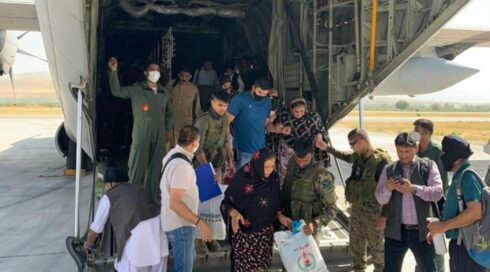
AI 1956 enroute to Delhi from Dushanbe carrying 78 passengers, including 25 Indian nationals. (Twitter/MEAIndia)
Even though Ahmadullah Wasiq, deputy spokesman for the Islamic Emirate of Afghanistan (IEA), acknowledged the importance of their relationship with India, the close ties between the Taliban and Pakistan, India’s archrival, makes it unconvincing for New Delhi that the change of regime will not impact their regional interests. The Zaranj-Delaram highway and the INSTC trade route, linking India to the resources rich soil of Afghanistan, is of significant importance to New Delhi, considering Pakistan doesn’t allow goods to enter India from its borders. Their decades-long anti-taliban support might just
work against them in this period of turmoil in the region.
From China’s perspective, the change of regime brings an interesting renewal to their regional influence. For starters, President Xi Jinping’s Belt and Road Initiative (BRI), intended to pass through Afghan land, would economically unite more than 60 countries, from East Asia to Western Europe. With the BRI passing through Afghanistan, the Red Dragon would be able to not only reach its Iranian ally, but also the oil rich country of Saudi Arabia, which happens to be the largest exporter of oil to China with 15.9% of its crude oil imports.
By securing a sea, air (Wakhan Corridor) and Land (Xinjiang and Pakistan’s borders) through the newly formed IEA, Beijing would increase its capacities to sustain economic embargoes by the West in the near future. This matter is not ignored by the US. Biden’s new AUKUS pact between the US, UK and Australia provides the latter with Nuclear powered submarines and Tomahawk cruise missiles technologies, making it one of the most notable pact since the end of World War 2. This historical event will enable the West to contest Beijing’s influence in the South China Sea, thus effectively threatening the security of the Silk Road 2.0.
However, the constant threat from both the Afghan resistance and IS-K is surely not being taken lightly in the eyes of Beijing, considering it jeopardizes the security of their land trade route. If the Taliban wishes to conclude a productive deal with the Chinese administration, they need to ensure regional security first and thus, come out on top of the current Afghan crisis. The success of the exhaustion campaign led by both the resistance forces and the Islamic State will surely influence the outcome of the Kabul-Beijing collaboration.
Finally, some sources speculate that China might pressure the new Islamic Emirate to deport its Uyghurs population back to Xinjiang Uyghurs autonomous region, where they will be detained and submit to forced labor and strict religious restrictions. So far, the talks between the Taliban and Beijing only prohibit the former from becoming a safe haven for launching attacks into Xinjiang province, referring primarily to the Turkistan Islamic Party (TIP).
3. Forecast of the country’s near future
Much like the weather, even the most precise forecast might turn out wrong. In this case, the Afghan dust hasn’t settled yet, which makes it difficult to accurately identify all the key players in the months to come. The Taliban still have much to prove before being legitimized on the world stage. Although, if they can retain power long enough and, somehow, change people’s perspective on their political ideologies, Afghanistan might just become another Sharia Law-based country, much like its neighbors Iran, Pakistan and most of the Gulf Arab states. If the IEA are able to gain political legitimacy, most likely through the United Nations Security Council, they should stay in power for at least another few years.
It is clear that India has lost most of its influence in the region since the fall of Kabul. Continuing on their previous delivery of medicine, it might be wise for the country to become a major aid provider in the massive humanitarian crisis that is to come, thus reaffirming their intentions of a profitable collaboration
with the Kabul administration. The current food insecurity is likely to keep deteriorating until the country’s economy stabilizes. Although, this day won’t come without the support from the international community, hence the importance of India’s generous peace offerings.
For New Delhi to keep a grasp on its local interests, it will also need, at least partially, to come to terms with the relationship between Pakistan and the IEA. However, this contest of influence might raise the tension between the two countries and effectively heightened the hostilities in the disputed region of Kashmir. One thing is sure, India will not let their $3 billion previous worth of investment go to waste.
On the People’s Republic side, considering that its politico-military doctrine is more subtle than the highly kinetic approach of the US-led coalition, it would be surprising to see Beijing use its military forces offensively in Afghanistan for the near future. It is more probable that it will use the new dictatorial government’s forces as a proxy to control and secure its assets within the country, although the idea of a Chinese military base in the North-Eastern Badakhshan province has been floating around since 2018. It is obvious at this point that the Red Dragon has learned from its predecessors in the region, and that it refuses to become the new tombstone in the Graveyard of Empires.



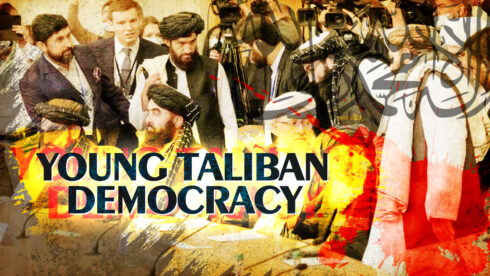



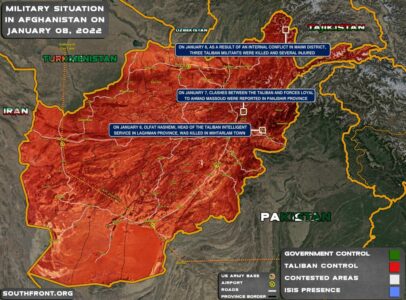
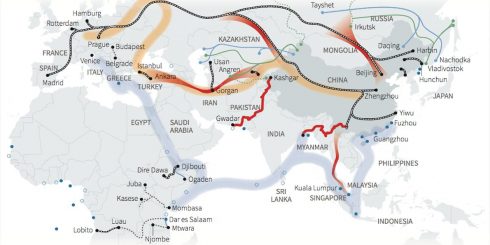



It appears to me that the Taliban joined the army as sleepers for when the time was ripe to rebel and put the yanks to flight. There seems to be no other explaination as to why the army was so quick to stop fighting and no hostilities were really evident as the Taliban advanced. It seemed only the drug barons of the north were interested in fighting.